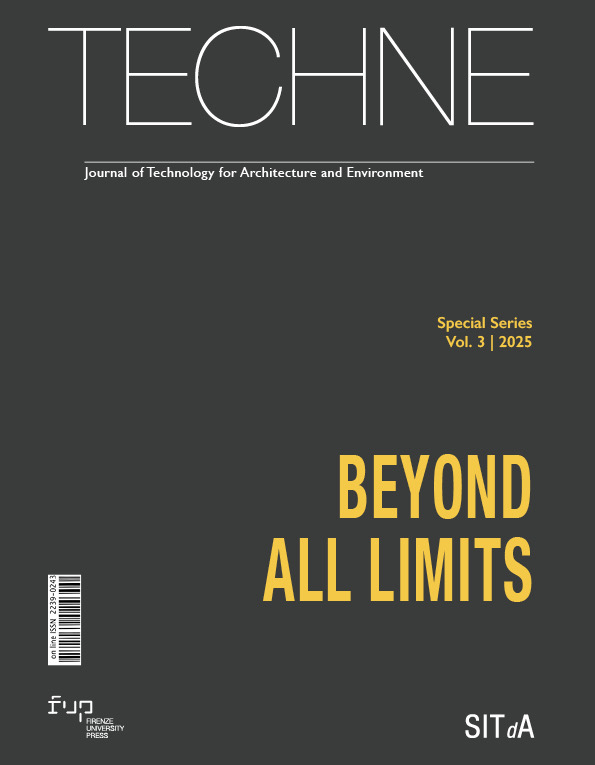Published 2025-07-31
Keywords
- Limits,
- Technological Process,
- Technological Product,
- Climate changes,
- Innovation
How to Cite
Copyright (c) 2025 Maria Luisa Germanà

This work is licensed under a Creative Commons Attribution 4.0 International License.
Abstract
The concept of limit offers an opportunity to summarise some milestones in the evolution of technological processes. Although this concept is theoretically and empirically problematic in the light of contemporary scenarios, both as a factor that generates processes and as a demarcation between nature and artifice, it remains essential in at least two areas, namely innovation and sustainability. Indeed, a series of material and immaterial limits influence, and sometimes impair, implementation of the technological processes. The incentive to manage these limits has often acted as a lever for innovation, both in terms of processes and products. Above all, dealing with limits has been at the heart of the orientation towards sustainability since its inception. The scientific community and the general public have come to terms with the finite nature of non-renewable natural resources and with the need to limit emissions. In both cases, the limit is used as a warning, with fear of the transition from alarm bell to death knell for the planet. The concept of limit is also relevant to the adaptation strategies to Climate Change. However, the concept of limit as something that clearly establishes a “within” and a “beyond” has supported a misleading dilemma in the face of the development of global economy. A change of approach is, therefore, called for, replacing the opposition of the limit by the integration of the continuum, bearing in mind that the right time and the right measure have always been an indispensable qualitative range for technological processes characterised by ethical principles.
Downloads
References
- Adger, W. N., Dessai S., Goulden M. et al. (2009), “Are there social limits to adaptation to climate change?”, Climatic Change vol. 93, pp. 335–354. DOI: https://doi.org/10.1007/s10584-008-9520-z
- Bardi, U. (2011), The Limits to Growth revisited, Spinger, New York Dordrecht Heidelberg London. DOI: https://doi.org/10.1007/978-1-4419-9416-5
- Butera, F. M. (2021), Affrontare la complessità. Per governare la transizione ecologica, Edizioni Ambiente, Milano.
- Castells, M. (1996), The Rise of the Network Society, Wiley-Blackwell, Chichester.
- Circle Economy (2024), The Circularity Gap Report 2024, Circle Economy, Amsterdam, available at: https://www.circularity-gap.world/2024#download
- DesRoches, C. T., Inkpen, S.A., Green, T.L. (2019), “The Eroding Artificial/Natural Distinction: Some Consequences for Ecology and Economics”, in Nagatsu M., Ruzzene A. (Eds.), Contemporary Philosophy and Social Science: An Interdisciplinary Dialogue, Bloomsbury Academic, London, pp. 39-57. DOI: https://doi.org/10.5040/9781474248785.ch-002
- Dymitrow, M. (2018), “Rural/Urban: laying bare the controversy”, Geographia Polonica vol. 91, pp. 375-397. DOI: https://doi.org/10.7163/GPol.0126
- Elhacham, E. et al., (2020), “Global human-made mass exceeds all living biomass”, Nature, vol. 588, p. 442-444. DOI: https://doi.org/10.1038/s41586-020-3010-5
- Germanaà, M. L. (2021), “The Urban-Rural Continuum. The Bioclimatic Approach to Design, Between Past and Future”, in Chiesa, G. (Ed.), Bioclimatic Approaches in Urban and Building Design. Springer, Cham, pp.153-175. DOI: https://doi.org/10.1007/978-3-030-59328-5_7
- Germanà, M. L. (2025), “Time in Environmental Design: How to Survive on the Fake Wings”, in Sayigh A., Trombadore A. and Calcagno G. (Eds.), Getting to Zero – Beyond Energy Transition Towards Carbon-Neutral Mediterranean Cities, Springer, Cham. DOI: https://doi.org/10.1007/978-3-031-82323-7_1
- Ialenti, S. (2023), “Oltre i confini del mondo: riflessioni sul limite ultimo”, in Gentile A. and Vossenkuhl W. (Eds.), The concept of «limit» in philosophical thought. Boundaries of reason and horizons of knowledge, Mon. iss. Areté International Journal of Philosophy, Human & Social Sciences” vol. 8, pp. 729-750.
- IPCC [Intergovernmental Panel on Climate Change] (2023), Climate Change 2023: Synthesis Report. Contribution of Working Groups I, II and III to the Sixth Assessment Report of the IPPC, pp. 35-115.
- Jonas, H. (1979), Das Prinzip Verantwortung, Insel Verlag, Frankfurt am Main.
- Klein, R. J. T., Midgley G. F., Preston B. L., et al. (2014), “Adaptation opportunities, constraints, and limits”, in IPPC, Climate Change 2014: Impacts, Adaptation, and Vulnerability, Cambridge University Press, Cambridge (UK) and New York, pp. 899-943.
- Meadows, D. H. et al. (1972), The Limits to Growth, Universe Book, New York. Pacey, A. (1986), The culture of technology, MIT Press, Cambridge Massachusetts.
- Rockström J., Steffen W., Noone K. et al., (2009), “Planetary boundaries: Exploring the safe operating space for humanity”, Ecology & Society, vol. 14, art. 32.
- Thomas, A., Theokritoff, E., Lesnikowski, A. et al. (2021), “Global evidence of constraints and limits to human adaptation”, Regional Environmental Change vol. 21, art. 85. DOI: https://doi.org/10.1007/s10113-021-01808-9
- UNCC [United Nations Climate Change] (2016), Paris Agreement, available at https://unfccc.int/sites/default/files/french_paris_agreement.pdf






